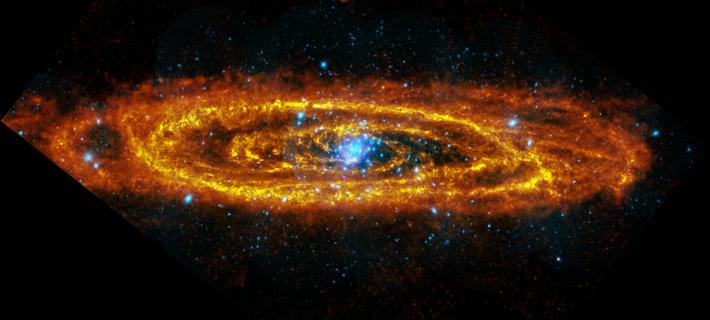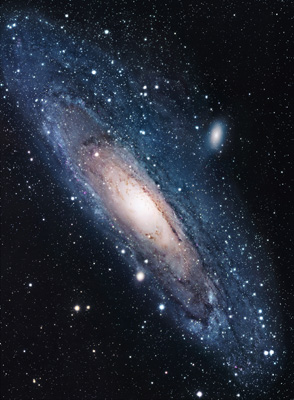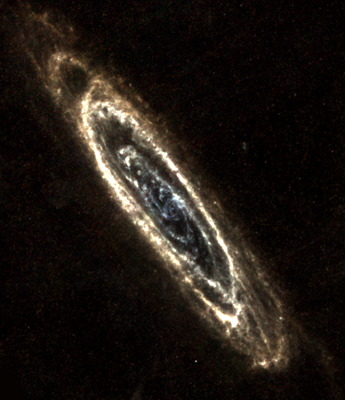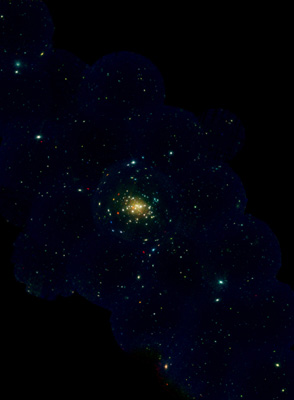| Basic Information | |
| What is this? | The Andromeda Galaxy (Messier 31) |
| Where is it in the sky? | In the constellation of Andromeda the Princess |
| How big is it? | The galaxy is a similar size to our own, around 100,000 light years across and containing around 100 billion stars |
| How far away is it? | At 2.5 million light years away, it is one of the closest galaxies to us |
| What do the colours represent? | Orange represents infrared light from Herschel, while Blue shows the x-rays detected by XMM-Newton |
Downloads
See this object in:
Update: you can see a video of the Andromeda Galaxy at a range of wavelengths over on the ESA website.
Over the Christmas period of 2010, the Herschel and ESA’s XMM-Newton satellite took images of our Galaxy’s nearest large neighbour, the Andromeda Galaxy. Galaxies such as our own Milky Way are often described as island Universes, containing hundreds of billions of stars and measuring tens or hundreds of thousands of light years across. But they are rarely completely isolated, and the Milky Way is accompanied by the Andromeda Galaxy. At a relatively close distance of 2.5 million light years, Andromeda is very similar in size to the Milky Way, and provides a way to study star formation on galaxy-wide scales in great detail.
Its proximity makes the Andromeda Galaxy (aka M31) appear very large in the sky, as wide as almost 6 full moons, and on a dark night the bright central core can sometimes even be seen with the naked eye. In optical light, the stars are seen to form spiral arms of stars, separated by dark dust lanes, all slightly tilted over from our point of view. Both the Herschel and XMM-Newton observatories reveal regions of star formation in the Andromeda Galaxy: Herschel observes in the far infrared, while XMM-Newton is sensitive to X-Rays.
While Herschel shows the cool and cold dust that shines because it is heated by the massive young stars that are forming within the dust clouds, XMM-Newton shows the endpoints of stellar evolution: on the one hand shock waves and ejected material in supernovae remnants, and on the other hand massive objects often in close binary systems. Professor Walter Gear, of Cardiff University, said “this image will allow us to study the global star formation in a galaxy remarkably similar to our own, but from the outside rather than with the limited view of our own galaxy we get from the inside”.
The Andromeda Galaxy is particularly interesting because, unlike other bright galaxies, it shows a large ring of dust that is about 75,000 light years across around the centre of the galaxy. Some astronomers speculate that this dust ring may have been formed in a recent collision with another galaxy. The Herschel image reveals intricate detail, with several rings of star-forming dust visible. Dr Jacopo Fritz, of Universiteit Ghent, leads the “HELGA” project which is using Herschel to observe the Andromeda Galaxy. He said “combining Herschel’s high sensitivity and spatial resolution, together with the huge size of the sky region that we observed (about 50 times the area of the full moon), we will be able, for the first time ever, to dig into the characteristics of such structures at these wavelengths, possibly linking them to the very cold dust in the most remote outskirts of Andromeda”.
XMM-Newton shows hundreds of x-ray sources within the galaxy, many of them clustered around the centre, where the stars are densest. The red sources in the x-ray image on the left are low-mass objects that emit only very low energy x-rays. Some of these sources are novae with a white dwarf star that gradually is accreting material from its larger companion. In these systems the white dwarf may eventually grow massive enough to collapse catastrophically and explode as a supernova. In contrast, the brighter, bluer x-ray sources are likely to be binary systems in which a neutron star or a black hole formed by the death of a star many times more massive than our Sun rotates around a normal star. For more composite images of the Andromeda Galaxy, click here or see the “annotated images” links below the main image above.
Using all three wavelength channels observed by the SPIRE instrument on Herschel, the temperature of the dust can be calculated. The dust ring is clearly visible as a bright white ring. The central regions of the galaxy appear bluer, indicating that the dust is slightly warmer, being heated by the intense light from the stars in the central bulge of the galaxy.
Both parts of the spectrum observed by Herschel and XMM-Newton are inaccessible from the ground, due to our atmosphere. Between the two images obtained by these two ESA space observatories we get a unique insight into the history of star formation in our galactic neighbour, from vigorous young stars in the process of formation, through to stars that have died, or are going to die a violent death. Professor Matt Griffin, of Cardiff University, and lead scientist of the SPIRE instrument, said “the superb three-colour SPIRE image shows us the big picture of star formation in spiral galaxies, and its striking combination with the X-ray image demonstrates the scientific power and beauty of space astronomy”.
The Andromeda Galaxy is particularly interesting because, unlike other bright galaxies, it shows a large ring of dust that is about 75,000 light years across around the centre of the galaxy. Some astronomers speculate that this dust ring may have been formed in a recent collision with another galaxy. The Herschel image reveals intricate detail, with several rings of star-forming dust visible. Dr Jacopo Fritz, of Universiteit Ghent, leads the ” HELGA ” project which is using Herschel to observe the Andromeda Galaxy. He said “combining Herschel’s high sensitivity and spatial resolution, together with the huge size of the sky region that we observed (about 50 times the area of the full moon), we will be able, for the first time ever, to dig into the characteristics of such structures at these wavelengths, possibly linking them to the very cold dust in the most remote outskirts of Andromeda”.
XMM-Newton shows hundreds of x-ray sources within the galaxy, many of them clustered around the centre, where the stars are densest. The red sources in the x-ray image on the left are low-mass objects that emit only very low energy x-rays. Some of these sources are novae with a white dwarf star that gradually is accreting material from its larger companion. In these systems the white dwarf may eventually grow massive enough to collapse catastrophically and explode as a supernova. In contrast, the brighter, bluer x-ray sources are likely to be binary systems in which a neutron star or a black hole formed by the death of a star many times more massive than our Sun rotates around a normal star. For more composite images of the Andromeda Galaxy, click here or see the “annotated images” links below the main image above.
Using all three wavelength channels observed by the SPIRE instrument on Herschel, the temperature of the dust can be calculated. The dust ring is clearly visible as a bright white ring. The central regions of the galaxy appear bluer, indicating that the dust is slightly warmer, being heated by the intense light from the stars in the central bulge of the galaxy.
Both parts of the spectrum observed by Herschel and XMM-Newton are inaccessible from the ground, due to our atmosphere. Between the two images obtained by these two ESA space observatories we get a unique insight into the history of star formation in our galactic neighbour, from vigorous young stars in the process of formation, through to stars that have died, or are going to die a violent death. Professor Matt Griffin, of Cardiff University, and lead scientist of the SPIRE instrument, said “the superb three-colour SPIRE image shows us the big picture of star formation in spiral galaxies, and its striking combination with the X-ray image demonstrates the scientific power and beauty of space astronomy”.




